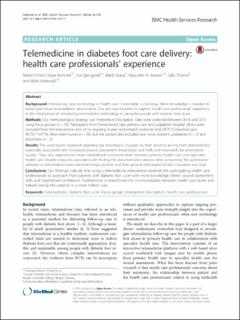| dc.contributor.author | Kolltveit, Beate-Christin Hope | |
| dc.contributor.author | Gjengedal, Eva | |
| dc.contributor.author | Graue, Marit | |
| dc.contributor.author | Iversen, Marjolein M. | |
| dc.contributor.author | Thorne, Sally | |
| dc.contributor.author | Kirkevold, Marit | |
| dc.date.accessioned | 2021-05-10T13:12:13Z | |
| dc.date.available | 2021-05-10T13:12:13Z | |
| dc.date.created | 2016-09-20T10:28:40Z | |
| dc.date.issued | 2016 | |
| dc.identifier.citation | BMC Health Services Research. 2016, 16:134 1-8. | |
| dc.identifier.issn | 1472-6963 | |
| dc.identifier.uri | https://hdl.handle.net/11250/2754720 | |
| dc.description.abstract | Background: Introducing new technology in health care is inevitably a challenge. More knowledge is needed to better plan future telemedicine interventions. Our aim was therefore to explore health care professionals’ experience in the initial phase of introducing telemedicine technology in caring for people with diabetic foot ulcers. Methods: Our methodological strategy was Interpretive Description. Data were collected between 2014 and 2015 using focus groups (n = 10). Participants from home-based care, primary care and outpatient hospital clinics were recruited from the intervention arm of an ongoing cluster randomized controlled trial (RCT) (Clinicaltrials.gov: NCT01710774). Most were nurses (n = 29), but the sample also included one nurse assistant, podiatrists (n = 2) and physicians (n = 2). Results: The participants reported experiencing meaningful changes to their practice arising from telemedicine, especially associated with increased wound assessment knowledge and skills and improved documentation quality. They also experienced more streamlined communication between primary health care and specialist health care. Despite obstacles associated with finding the documentation process time consuming, the participants’ attitudes to telemedicine were overwhelmingly positive and their general enthusiasm for the innovation was high. Conclusions: Our findings indicate that using a telemedicine intervention enabled the participating health care professionals to approach their patients with diabetic foot ulcer with more knowledge, better wound assessment skills and heightened confidence. Furthermore, it streamlined the communication between health care levels and helped seeing the patients in a more holistic way. Keywords: telemedicine, diabetic foot ulcer, focus groups, interpretive description, health care professionals | |
| dc.language.iso | eng | |
| dc.rights | Navngivelse 4.0 Internasjonal | |
| dc.rights.uri | http://creativecommons.org/licenses/by/4.0/deed.no | |
| dc.title | Telemedicine in diabetes foot care delivery : health care professionals’ experience | |
| dc.type | Peer reviewed | |
| dc.type | Journal article | |
| dc.description.version | publishedVersion | |
| dc.source.pagenumber | 1-8 | |
| dc.source.volume | 16:134 | |
| dc.source.journal | BMC Health Services Research | |
| dc.identifier.doi | 10.1186/s12913-016-1377-7 | |
| dc.identifier.cristin | 1383133 | |
| dc.relation.project | Norges forskningsråd: 221065 | |
| cristin.unitcode | 211,2,0,0 | |
| cristin.unitname | Avdeling for helse- og sosialfag | |
| cristin.ispublished | true | |
| cristin.fulltext | original | |
| cristin.qualitycode | 2 | |

